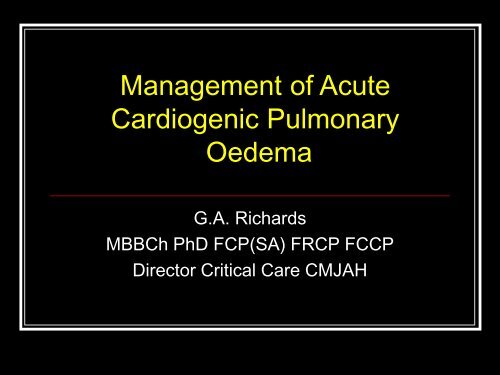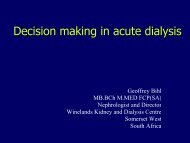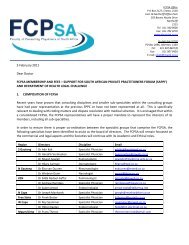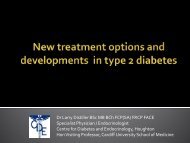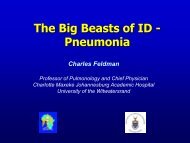Management of Acute Cardiogenic Pulmonary Oedema
Management of Acute Cardiogenic Pulmonary Oedema
Management of Acute Cardiogenic Pulmonary Oedema
- No tags were found...
Create successful ePaper yourself
Turn your PDF publications into a flip-book with our unique Google optimized e-Paper software.
<strong>Management</strong> <strong>of</strong> <strong>Acute</strong><strong>Cardiogenic</strong> <strong>Pulmonary</strong><strong>Oedema</strong>G.A. RichardsMBBCh PhD FCP(SA) FRCP FCCPDirector Critical Care CMJAH
• Hypertension• IschaemiaCauses <strong>of</strong> LV Failure• Muscle (CMO, drugs, toxins, infiltrative,nutritional, endocrine, HIV, peripartum)• Valvular• Congenital
Prognosis• 50% are dead at 4 yrs• 40% <strong>of</strong> those admitted with HF are dead orreadmitted within 4 yearsEuropean Journal <strong>of</strong> Heart Failure (2008), 933–989
Dickstein ESC Guidelines: Eur J Heart Failure 2008
Diastolic HF: HFPEF• Symptoms ± signs <strong>of</strong> HF & preserved LVEF(40–50%) (no consensus on cut-<strong>of</strong>f for“preserved EF”)• Clinical diagnosis alone inadequate, esp in♀, elderly, obese• HFPEF is present in 50%• Prognosis similar to systolic HFRemes Eur Heart J 1991Wheeldon Q J Med 1993Owan N Engl J Med 2006
Diagnosis <strong>of</strong> HFPEF• Requires 3 conditions• Signs and/or symptoms <strong>of</strong> chronic HF• Normal or mildly abnormal LV systolic function• Diastolic dysfunction (abnormal relaxation ordiastolic stiffness)
Diagnosis <strong>of</strong> Heart FailureDickstein ESC Guidelines: Eur J Heart Failure 2008
Therapeutic Modalities:• Oxygen• Non-invasive ventilation• Loop diuretics• Vasodilators• Inotropic agents• Cardiac glycosides• Morphine
ACPO is Frequently not Associatedwith Systemic CongestionDickstein ESC Guidelines: Eur J Heart Failure 2008
Worsening/decompensated CHF• Peripheral oedema/congestion:• Systemic congestion with low BP• Often both RV and LV dysfunction so LApressure not increased• Poor prognosis• <strong>Pulmonary</strong> congestion less common
<strong>Pulmonary</strong> CongestionRARVLUNGINCREASEDLATV PA PV MitralPRESSURELV
<strong>Acute</strong> <strong>Pulmonary</strong> <strong>Oedema</strong>:Hypertensive HF• High BP: systolic function mostly preserved• Increased sympathetic tone, tachycardia,vasoconstriction• No systemic congestion; Euvolaemic ormildly hypervolaemic• <strong>Pulmonary</strong> congestion
Isolated right HF:• Low output syndrome• Increased JVP± hepatomegaly• Low LV filling pressures• No pulmonary congestion
ACS and HF• 15% <strong>of</strong> patients with ACS have signs andsymptoms <strong>of</strong> HF• HF frequently associated with/precipitatedby arrhythmia (bradycardia, AF, VT)• Not hypervolaemic at onset <strong>of</strong> ischaemia
Classification <strong>of</strong> HF severity inMI: KillipKillip Am J Cardiol 1967
Classification <strong>of</strong> HF severity inMI: ForresterForrester Am J Cardiol 1977
Tako-tsubo• “Stress-induced CMO”, “broken heart” or“transient LV apical ballooning syndrome”• 0.7–2.5% patients with apparent ACS• Preceding hypertension in 43-76%• Primarily older ♀ (90%), acute emotional/physiologic stress; also younger patientsand ♂, not always with stressful eventsPilgrim Int J Cardiol 2008Sharkey J Am Coll Cardiol 2010
Tako-tsubo: Diagnostic Criteria• Transient hypo-, akinesis in LV mid segments± apical involvement in >1 vessel distribution• Absence <strong>of</strong> OCAD or plaque rupture on angio• New ECG abnormalities/ modest Tn elevation• Absence <strong>of</strong> myocarditis or phaeoPrasad Am Heart J 2008
Tako-tsubo: Mechanisms• Myocardial stunning: ? due to catecholamineor ischaemia-mediated multivessel,epicardial or microvascular spasm, abortedMI, or focal myocarditis• Why selective apical LV dysfunction isunknown; possibly increased responsiveness<strong>of</strong> apical myocardium to SNS stimulation
Tako-tsubo• Symptoms: ACS or ACPO• Minimal ST elevation in precordial leads• Small Tn elevation (peak < 24h), low forthe extensive wall motion abnormalities:Ramaraj Exp Clin Cardiol 2009Sharkey Am J Cardiol 2008
Tako-tsubo: Systole: No contraction inapical region and apical ballooningZeb Postgrad Med J 2011
ACPO: Diuretics• ACPO without pre-existent systemiccongestion generally causes intravascularvolume depletion• Diuretics may cause further dehydrationand exacerbate renal failure
ACPO: Conditions where diureticsmay not be valuable• Hypertensive heart failure• <strong>Acute</strong> ischaemia/MI• HFPEF• Tako Tsubo• HOCM• Negaitive pressure pulmonary oedema
Therapy: Oxygen• Recommended as early as possible toachieve saturation ≥ 95% (less in COPD)
NIV: Haemodynamic Response• RV preload reduced by IPPV•RV afterload determined by effect on PVR•Alveolar vessels: degree <strong>of</strong> alveolaroverdistension•Extra alveolar interstitial vessels:atelectasis or recruitmentMagder: ICM 1998Pinsky: JAP 1984; Crit Care Clin 1990Marini: ARRD 1987
LV preloadInfluenced by• RV preload• RV afterload• Ventricular interdependence
LV AfterloadDetermined by:• Ventricular work: SVR and BP• Cavity size Tension ∞ radius (Laplace)• Transmural pressure (tension)IPPV reduces: cavity size andtransmural tension
HemodynamicsPreloadCavity sizeSVRStrokevolumeBPContractilityMuscleshorteningAfterloadHRC.O.±ITP
LV Afterload: Transmural TensionIPPV increases ITP reducing transmural tensionMean Arterial Pressure 60ITPT TT TMean Airway Pressure +20T T =Transmural tension = 60-20 +20=80 = 40
Afterload: Negative Pressure<strong>Pulmonary</strong> <strong>Oedema</strong>• Markedly negative swings in ITP fromspontaneous ventilation increasesafterload and may precipitate ACPOparticularly with LV dysfunction• This can also occur in well compensatedpatients. Young fit malesStalcup: NEJM 1977S<strong>of</strong>er: Chest 1984Beach: CCM 1973
Therapy: NIV with PEEP• Consider as early as possible with ACPO• Improves clinical parameters and LVfunction by reducing LV afterload• 3 meta-analyses showed reduced intubationand short-term mortalityMasip Heart Fail Rev 2007 &JAMA 2005Peter Lancet 2006
Clinical Effects <strong>of</strong> NIV• 30 extubated low risk patients:• 4 intervals: spontaneous ventilation, NIV,spontaneous, NIV• CI & S mv O 2 increased significantly with NIV• UO increased significantlyH<strong>of</strong>fman Thorac Cardiovasc Surg 2003
CPAP vs. Conventional therapy• 5 trials: significant improvement in gasexchange and intubation ratesRasanen Am J Cardiol 1985Lin J Formosan Med Assoc 1991Bersten NEJM 1991Lin Chest 1995L’Her ICM 2004• The latter demonstrated a reduction inmortality with CPAP
CPAP vs. BiPAP80 patients conventional therapy; CPAP11cm H 2 O vs BiPAP 17/11• CPAP/BiPAP significantly improveddyspnoea, vital signs, P/F ratios• Study stopped due to significant intubationdifference 42 vs 7% CPAP & BiPAP• 15day mortality higher with O 2 alone p< .05• Mortality hospital discharge not differentPark CCM 2004
CPAP: Practicalities• 5– 7.5cmH 2 O titrated to 10cmH 2 O• FiO 2 >0.4• Contraindications• Poor cooperation• Immediate need for intubation• Caution with ++ secretions
Measure Fluid Status: SVV
Fluid Status: SVV/PPVMeta-analysis <strong>of</strong> 29 studies during MV:• >12% predicted fluid responsiveness• Sensitivity, specificity: PPV: 0.89 and 0.88SVV: 0.82 and 0.86PPV more accurate (direct vs. derived)Reliable only if TV ≥8 mL/kg and nospontaneous breathingDe Backer ICM 2005Marik CCM 2009
Thermodilution TechniqueCold bolusinjectionMeasurement<strong>of</strong> thermodilution
Thermodilution Decay CurveITTV = CO * MTtPTV = CO * DStMTt: : Mean transit timeDSt: : Downslope timeBelda FJ 26 th ISICEM Brussels 2006
CO x MTt= Vd <strong>of</strong> cold indicator=IT Thermal VolumeCO x DSt= Cold indicator mixing chamberP Thermal VolumeCO x (MTt- DSt)=GEDVITBV (PBV)= 1,25 x GEDVEVLW = ITTV- ITBVMichard Crit Care Med 2007
Fluid Status: GEDV/ITBV• Lower values indicate volume-depletion• Confirmatory evidence <strong>of</strong> fluid depletion espatrial fib, spontaneous ventilation• Fluid responsive CI corresponds with anincrease in GEDVI and ITBVI• But increased CI from inotropes leavesGEDVI/ITBVI unchangedBerkenstadt Anesth Analg 2001
Fluid Status: EVLW• >EVLWI associated with more severeARDS/LIS and higher mortality• No consensus on normals or indexingparameters• Predicted BW may be superior to predictmortality, MOF and diagnose ARDS• Valuable confirmatory evidence <strong>of</strong> fluiddepletionChew Crit Care 2012Chung PLoS One 2010Effros Am J Physiol Lung Cell Mol Physiol 2008Maharaj Cardiol Res Pract 2012Camporota Critical Care 2012
“Normal Values”• CI 3.0 – 5.0 l/min/m 2• GEDVI 680 – 800 ml/m 2• ITBI(PBV) 850- 1000ml/m 2• SVV 10 %• ELWI 3.0 – 7.0ml/kg (<strong>Oedema</strong>: >10mL/kg)
Interface
Case Study CVP 8Male 56: Post extubationdypspneaPink frothy sputumConfusedPost extubation Pulm oedema:∆∆- LV dysfunction/MI- Negative pressurepulmonary oedemaIntervention: Fluids: if responseinadequate, dobutamineMAP 70PEEP 12P/F 68CI 1.6SVV 22SVRI 2800EVLW 18ml/kgGEDV 400ml/m 2


